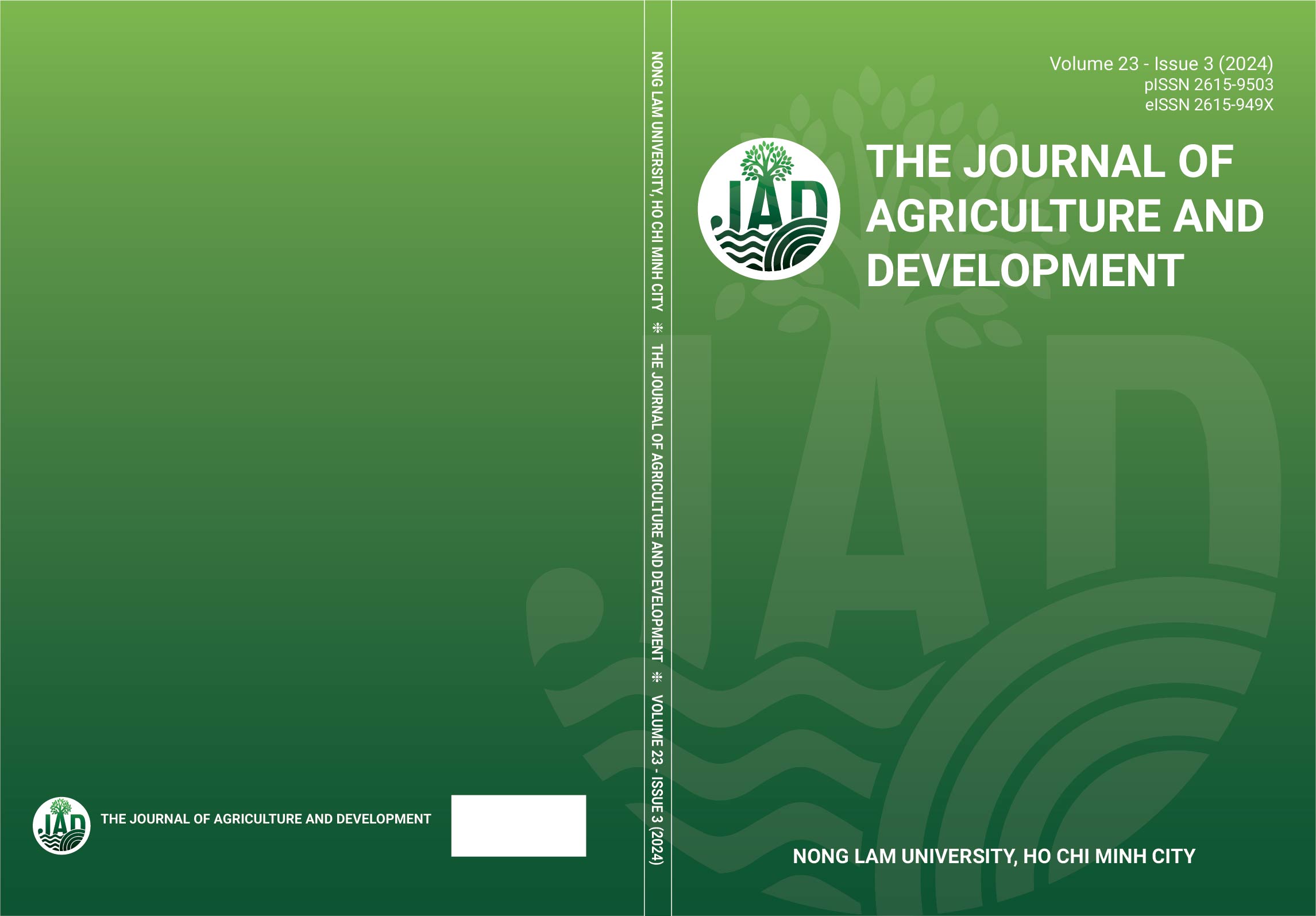Influence of the supplementation of macadamia oil cake powder on nutritional and sensory qualities of bread
Main Article Content
Abstract
Although macadamia oil cake (MOC) is a by-product of macadamia oil processing, this material still has high nutritional value, making it a promising ingredient for food products. This study aimed to investigate effects of the MOC supplementation at different ratios on physical properties, nutritional composition and sensory quality of bread. The results show that the addition of MOC led to increases in protein, ash and fat content, while carbohydrate content was lower in the supplemented bread. The specific volume and springiness of the bread were significantly affected by the MOC supplementation while no significant change in hardness and spread ratio was observed (P < 0.05). For the sensory quality of fortified bread, the differences in color, flavor, texture and overall acceptability among 4 levels of MOC addition were insignificant, except for the taste score. Microbiological analyses also confirmed that the MOC supplemented bread product met microbial safety standards. The obtained results suggest that the bread sample with 20% MOC addition (9.35 g protein, 12.32 g fat, 46.13 g carbohydrate, 4.29 g dietary fiber and 332.77 kcal per 100 g) should be selected for developing high nutritional bread product.
Article Details
References
Acheampong-Boateng, O., Bakare, A. G., Nkosi, D. B., & Mbatha, K. R. (2017). Effects of different dietary inclusion levels of macadamia oil cake on growth performance and carcass characteristics in South African mutton merino lambs. Tropical Animal Health and Production 49(4), 733-738. https://doi.org/10.1007/s11250-017-1250-7.
Al-Nasiry, B. S. A. N. (2020). Detection of bacterial contamination in filled and dried biscuit products of young children. Annals of Tropical Medicine and Health 23(16), 231-602. https://doi.org/10.36295/asro.2020.231602.
Andersson, A., Ronner, U., & Granum, P. E. (1995). What problems does the food industry have with the spore-forming pathogens Bacillus cereus and clostridium perfringens? International Journal of Food Microbiology 28(2), 145-155. https://doi.org/10.1016/0168-1605(95)00053-4.
Behera, S., Indumathi, K., Mahadevamma, S., & Sudha, M. L. (2013). Oil cakes-a by-product of agriculture industry as a fortificant in bakery products. International Journal of Food Sciences and Nutrition 64(7), 806-814. https://doi.org/10.3109/09637486.2013.801405.
Bilge, G., Sezer, B., Eseller, K. E., Berberoglu, H., Koksel, H., & Boyaci, I. H. (2016). Ash analysis of flour sample by using laser-induced breakdown spectroscopy. Spectrochimica Acta Part B: Atomic Spectroscopy 124, 74-78. https://doi.org/10.1016/j.sab.2016.08.023.
Bolarinwa, I. F., Aruna, T. E., & Raji, A. O. (2019). Nutritive value and acceptability of bread fortified with moringa seed powder. Journal of the Saudi Society of Agricultural Sciences 18(2), 195-200. https://doi.org/10.1016/j.jssas.2017.05.002.
Demirkesen, I. (2016). Formulation of chestnut cookies and their rheological and quality characteristics. Journal of Food Quality 39(4), 264-273. https://doi.org/10.1111/jfq.12209.
FAO (Food and Agriculture Organization). (2019). Chapter 2: Methods of food analysis. Retrieved February 20, 2024, from https://www.fao.org/4/Y5022E/y5022e03.htm.
Ghoshal, G., & Kaushik, P. (2020). Development of soymeal fortified cookies to combat malnutrition. Legume Science 2(3), e43. https://doi.org/10.1002/leg3.43.
Kačániová, M., & Juhaniaková, L. (2011). Microorganisms in confectionery products. Journal of Microbiology, Biotechnology and Food Sciences 1(1), 57-69.
Kumala, T., Sutrisno, A., & Yunianta (2020). Glucomannan as an anti-staling agent to improve the texture value of whole wheat bread. IOP Conference Series: Earth and Environmental
Science 475. https://doi.org/10.1088/1755-1315/475/1/012030.
Lee, C. A., & Labbé, R. (2016). Distribution of enterotoxigenic clostridium perfringens spores in US retail spices. Journal of Food Protection 81(3), 394-399. https://doi.org/10.4315/0362-028X.JFP-17-352.
Loureiro, V., & Querol, A. (1999). The prevalence and control of spoilage yeasts in foods and beverages. Trends in Food Science and Technology 10(11), 356-365. https://doi.org/10.1016/S0924-2244(00)00021-2.
Maturin, L., & Peeler, J. T. (2001). BAM Chapter 3: Aerobic plate count. Maryland, USA: US Food and Drug Administration.
Mokrzycki, W., & Tatol, M. (2011). Colour difference delta E-A survey. Machine Graphics and Vision 20(4), 383-411.
Munro, I., & Garg, M. (2008). Nutrient composition and health benefi cial effects of macadamia nuts. In Alasalvar, C., & Shahidi, F. (Eds.). Tree Nuts: Composition, phytochemicals and health effects (1st ed., 263-272). Florida, USA: CRC Press.
Navarro, S. L. B., & Rodrigues, C. E. C. (2016). Macadamia oil extraction methods and uses for the defatted meal byproduct. Trends in Food Science and Technology 54, 148-154. https://doi.org/10.1016/j.tifs.2016.04.001.
Oguntoyinbo, O. O., Olumurewa, J. A. V., & Omoba, O. S. (2021). Physico-chemical and sensory properties of cookies produced from composite flours of wheat and banana peel flours. Journal of Food Stability 4(3), 1-21.
Oranusi, S., Braide, W., & Oguoma, O. I. (2013). Antifungal properties of lactic acid bacteria (LAB) isolated from ricinus communis, pentaclethra macrophylla and yoghurts. Global Advanced Research Journal of Food Science and Technology 21, 01-06.
Plazzotta, S., Sillani, S., & Manzocco, L. (2018). Exploitation of lettuce waste flour to increase bread functionality: effect on physical, nutritional, sensory properties and on consumer response. International Journal of Food Science and Technology 53(10), 2290-2297. https://doi.org/10.1111/ijfs.13820.
Pojić, M., Hadnađev, T. D., Hadnađev, M., Rakita, S., & Brlek, T. (2015). Bread supplementation with hemp seed cake: A by‐product of hemp oil processing. Journal of Food Quality 38(6), 431-440. https://doi.org/10.1111/jfq.12159.
Pycia, K., Kapusta, I., & Jaworska, G. (2020). Walnut oil and oilcake affect selected the physicochemical and antioxidant properties of wheat bread enriched with them. Journal of Food Processing and Preservation 44(8), e14573. https://doi.org/10.1111/jfpp.14573.
Sarkis, J. R., Côrrea, A. P. F., Michel, I., Brandeli, A., Tessaro, I. C., & Marczak, L. D. F. (2014). Evaluation of the phenolic content and antioxidant activity of different seed and nut cakes from the edible oil industry. Journal of the American Oil Chemists' Society 91(10), 1773-1782. https://doi.org/10.1007/s11746-014-2514-2.
Szydłowska-Czerniak, A., Poliński, S., & Momot, M. (2021). Optimization of ingredients for biscuits enriched with rapeseed press cake-changes in their antioxidant and sensory properties. Applied Sciences 11(4), 1558. https://doi.org/10.3390/app11041558.
Tominaga, T., & Ishii, M. (2020). Chapter 11 - Detection of microorganisms with lateral flow test strips. Methods in Microbiology 47, 351-394. https://doi.org/10.1016/bs.mim.2019.11.007.








